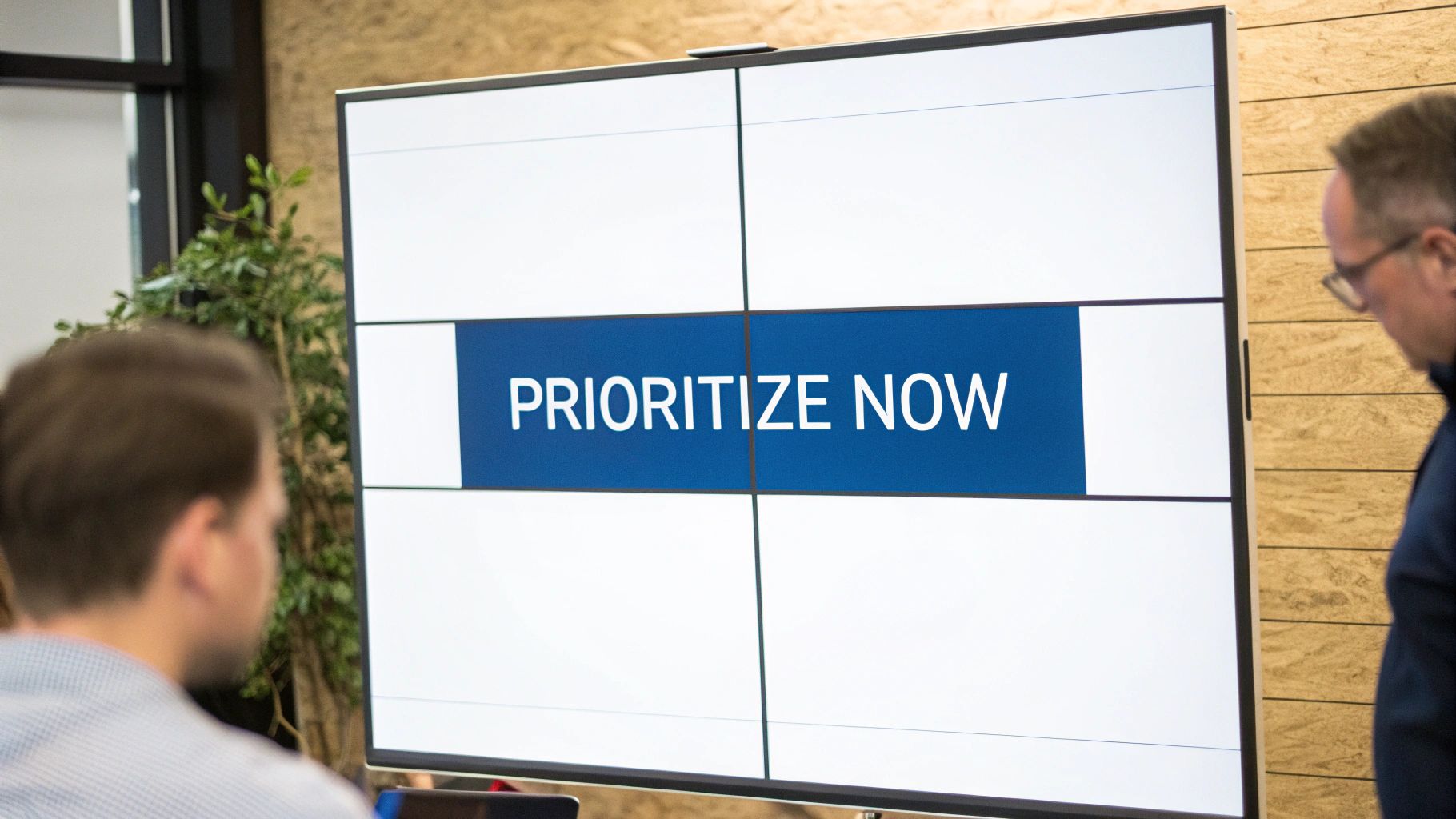Boost Productivity with Task Prioritization Techniques
Unlocking Your Productivity Potential
Feeling swamped by a constantly growing to-do list? Overwhelmed and unproductive? This is a common struggle, especially in demanding fields like law, healthcare, and security & compliance. Juggling urgent requests, deadlines, and important (but not urgent) tasks can quickly lead to burnout and reduced effectiveness.
Effective task prioritization is no longer optional—it's essential for thriving in today's fast-paced professional world.
The Evolution of Task Prioritization
Task management has come a long way from simple to-do lists to the complex methodologies used in modern project management. Early approaches like the Pareto Principle (the 80/20 rule) emphasized focusing on the most impactful tasks. This principle, combined with the Eisenhower Matrix (Urgent/Important matrix), formed the basis for many current prioritization techniques.
A truly effective method provides clarity, aligns with your goals, and adapts to changing situations. It helps you pinpoint high-impact tasks, minimize distractions, and strategically manage your time and energy.
Mastering Your To-Do List
This article explores powerful task prioritization techniques to regain control of your schedule, reduce stress, and boost productivity. Discover how to identify your key priorities, streamline your workflow, and accomplish more with less effort. You'll gain valuable tools to conquer your to-do list and unlock your full potential, no matter the demands of your profession.
The Eisenhower Matrix: Mastering Time Management
The Eisenhower Matrix, also known as the Urgent-Important Matrix, is a valuable tool for prioritizing tasks. It helps individuals and teams manage their workload effectively by categorizing tasks based on urgency and importance. This straightforward approach is especially useful for busy professionals in demanding fields like law, healthcare, and security & compliance.

Understanding the Four Quadrants
The matrix divides tasks into four distinct quadrants:
- Do First (Important and Urgent): This quadrant includes crises, deadlines, and pressing problems requiring immediate action. Examples include a legal professional filing an urgent motion, a healthcare provider responding to a medical emergency, or a security officer addressing a critical breach.
- Schedule (Important but Not Urgent): This quadrant houses tasks essential for long-term success. These often include planning, relationship building, and professional development. Think drafting a complex legal strategy, developing a patient care plan, or implementing a new security protocol. While these tasks are often neglected, proactive scheduling ensures they receive the necessary attention.
- Delegate (Urgent but Not Important): This quadrant contains urgent tasks that don't significantly contribute to overall goals. These tasks are often suitable for delegation. A lawyer might delegate scheduling client meetings, a healthcare provider might delegate administrative tasks, and a compliance officer might delegate routine audits.
- Eliminate (Not Urgent and Not Important): This quadrant includes time-wasting activities that offer minimal value. Examples are excessive social media use or unproductive meetings. Eliminating these tasks frees up valuable time for higher priorities.
Benefits and Drawbacks of the Eisenhower Matrix
The 2x2 matrix provides a visual and intuitive framework for prioritizing tasks. It encourages strategic evaluation of each activity and promotes proactive planning. This clarity can significantly reduce stress and improve productivity.
Pros:
- Simple and intuitive
- Eliminates time-wasting activities
- Encourages strategic thinking
- Reduces stress
Cons:
- Subjectivity in defining importance and urgency
- Doesn't account for task dependencies
- May oversimplify complex projects
- Requires regular reassessment
History and Usage
Popularized by U.S. President Dwight D. Eisenhower, the matrix gained further recognition through Stephen Covey's book, The 7 Habits of Highly Effective People. Even Microsoft CEO Satya Nadella reportedly uses this method.
Practical Tips and Tools
- Regular Review: Review and categorize tasks weekly, or even daily.
- Be Decisive: Eliminate or delegate non-important tasks.
- Control Urgency: Prevent less important urgent tasks from dominating your day.
- Digital Tools: Utilize productivity apps like Todoist and Trello, many of which offer Eisenhower Matrix templates.
The Eisenhower Matrix offers a simple yet powerful framework for making informed decisions about time and energy allocation. This leads to increased productivity and reduced stress, a significant advantage for professionals in demanding fields.
Getting Things Done (GTD): A Comprehensive Productivity System
Getting Things Done (GTD) is a productivity methodology developed by David Allen. It’s known for its comprehensive approach to task management. More than just prioritizing, GTD provides a complete system for capturing, organizing, and tackling your commitments. This frees your mind from the burden of trying to remember everything. GTD is especially helpful for busy professionals in demanding fields like law, healthcare, and security and compliance.
GTD is based on a five-step workflow: Capture, Clarify, Organize, Reflect, and Engage.
- Capture: Collect all your tasks, ideas, and projects into "inboxes." These could include physical notepads, voice recorders, or digital apps like Evernote.
- Clarify: Process each item you’ve captured. Determine if it’s actionable. If not, discard it, set it aside for later, or file it for reference. If it is actionable, define the very next physical action required to move it forward.
- Organize: Categorize your next actions by context (e.g., @Computer, @Phone, @Errands). Then prioritize these actions based on urgency and importance. Projects (anything requiring more than one action) are tracked separately, each with its own clearly defined next action.
- Reflect: Regularly review your entire GTD system, ideally every week. This ensures everything is up-to-date and allows you to re-prioritize tasks as needed. This weekly review is crucial for GTD's overall effectiveness.
- Engage: Choose actions to work on based on your current context, available time, and energy levels.
Context is Key
This context-based organization system is a defining feature of GTD. Rather than simply creating a to-do list, you group tasks based on the tools or location required to complete them. This lets you efficiently tackle similar tasks when the opportunity arises.
The Rise of GTD
GTD gained significant popularity with the growth of productivity blogs like 43Folders by Merlin Mann. Its proven effectiveness has led to its adoption by companies like Google and American Express. Many software tools, such as OmniFocus and Nirvana, are designed specifically to support GTD implementation.
Pros and Cons of GTD
Pros:
- Comprehensive system for managing all aspects of work and life
- Reduces mental clutter and stress
- Adaptable to both small personal tasks and large, complex projects
- Flexible implementation options
- Helps prevent tasks from being forgotten
Cons:
- Can have a steep initial learning curve
- Potential for becoming overly complex if not properly maintained
- Requires discipline and consistent reviews
- Some may find the full system too rigid or time-consuming
Tips for Implementing GTD
- Start Small: Begin with the "capture" phase. Get everything out of your head and into your chosen system before attempting the entire GTD workflow.
- Prioritize Weekly Reviews: Consistency with these reviews is crucial. They prevent your system from becoming overwhelming and help you maintain control.
- Define Concrete Next Actions: Avoid vague next actions like "Work on Project X." Instead, define a specific step like "Email John about Project X proposal."
- Use Waiting-For Lists: Track delegated tasks and make it easier to follow up effectively.
- Gradual Implementation: Don't try to implement the whole GTD system overnight. Focus on incorporating one element at a time.
You can explore other process improvement methods in our blog post on essential process improvement techniques. GTD can be a powerful tool for streamlining workflows and boosting efficiency, especially when combined with other strategic approaches. It offers a structured way to maintain control and maximize productivity, which is particularly beneficial for professionals in demanding fields like law, healthcare, and security and compliance.
The ABCDE Method: Prioritizing for Professionals
The ABCDE Method offers a powerful approach to prioritization, bringing much-needed clarity and structure to busy schedules. This method proves especially valuable for professionals in demanding fields like law, healthcare, and security, ensuring critical tasks get immediate attention. Its simple, hierarchical system promotes decisive action and reduces the feeling of being overwhelmed.
The method categorizes tasks into five priority levels:
- A (Must Do): Mission-critical tasks with serious consequences if left undone. These are your top priorities, demanding immediate action. Examples include responding to an urgent court filing, attending to a critical patient, or addressing a major security breach.
- B (Should Do): Important tasks, but with less urgent consequences than A-level tasks. These could include drafting legal documents, following up on patient test results, or reviewing security logs.
- C (Could Do): Tasks that are beneficial but can be postponed without significant impact. Think returning non-urgent calls, organizing files, or researching new security software.
- D (Delegate): Tasks that can be assigned to others, freeing up your time for higher priorities. This might involve assigning research to a paralegal, delegating patient intake to a nurse, or having a junior analyst perform vulnerability scans.
- E (Eliminate): Tasks that are no longer relevant or add little value. Be decisive and remove these tasks entirely. Examples include outdated reports, redundant meetings, or obsolete security protocols.
Within each category, tasks are numbered (A1, A2, B1, B2, etc.) to establish a clear order of execution. This sub-prioritization ensures you tackle the most crucial tasks within each level first.
Features and Benefits
The ABCDE Method's alphabetical structure makes it easy to understand and apply. It forces you to make tough prioritization decisions by considering the consequences of not completing a task. This focus on consequences is particularly important in fields like law, healthcare, and security, where inaction can have significant repercussions.
Pros and Cons
| Pros | Cons |
|---|---|
| Clear Hierarchy | Time Constraints & Dependencies |
| Decisive Prioritization | Overwhelming A-Tasks |
| Easy Implementation | Requires Honest Assessment |
| Effective for Daily To-Do Lists | Frequent Reprioritization |
Practical Examples
- Sales teams can prioritize leads, focusing on high-potential clients (A) before nurturing less qualified prospects (B or C).
- Customer service departments can handle support tickets, prioritizing critical system outages (A) over minor bugs (B).
- In healthcare, triage nurses can prioritize patients based on the urgency of their condition.
- Security officers can address vulnerabilities, starting with critical threats (A) before lower-risk issues.
Tips for Implementation
- Be Honest: Realistically assess what constitutes a true 'A' priority.
- Limit A-Tasks: Aim for 2-3 'A' tasks daily to avoid feeling overwhelmed.
- Review and Reprioritize: Adjust your list at the end of each day.
- Consider Consequences: When assigning a letter, think about the impact of not completing the task.
Origins and Popularity
The ABCDE Method gained popularity through Brian Tracy's book "Eat That Frog!" and Alan Lakein's "How to Get Control of Your Time and Your Life". These authors emphasized tackling the most challenging tasks first to maximize productivity and minimize procrastination.
Time Blocking: A Productivity Powerhouse
Time blocking is a highly effective scheduling method that transforms a simple to-do list into a dynamic, actionable plan. Instead of merely jotting down tasks, you dedicate specific time slots throughout your day for each activity, effectively turning your calendar into a personalized productivity roadmap. This structured approach ensures focused time for essential tasks and cultivates greater time awareness.

Time blocking is a proactive strategy. Instead of reacting to incoming demands, you proactively allocate time for your top priorities. This is especially helpful for busy professionals in demanding fields like law, healthcare, and security, who often face multiple complex tasks and urgent requests.
Key Features and Benefits
- Calendar-Based Task Management: Integrate tasks directly into your calendar for a complete overview of your daily schedule.
- Dedicated Time Slots: Allocate specific time blocks to individual tasks, encouraging focused work and minimizing distractions.
- Buffer Periods: Include short breaks between time blocks to allow for transitions, unexpected interruptions, and mental rejuvenation.
- Realistic Planning: Time blocking requires you to acknowledge time constraints, promoting realistic expectations about what you can accomplish.
- Integration of Tasks and Appointments: Seamlessly combine your work tasks with existing appointments for a comprehensive schedule.
Pros of Time Blocking
- Realistic Expectations: By considering your actual available time, you can set more achievable goals.
- Reduced Decision Fatigue: Eliminate the need to constantly decide your next task, freeing mental energy for focused work.
- Combats Procrastination: Dedicated time slots make it harder to postpone important tasks.
- Visible Time Commitments: Transform abstract to-dos into concrete calendar appointments, making your commitments more tangible.
- Improved Focus: Minimize multitasking and encourage deep work by dedicating specific blocks to individual activities.
Cons of Time Blocking
- Accurate Time Estimation: Requires practice and self-awareness to accurately estimate task duration.
- Potential Rigidity: Can feel restrictive, particularly when starting, if not implemented with flexibility.
- Adjustments for Interruptions: Requires adaptability to reschedule blocks when unexpected issues arise.
- Initial Time Investment: Setting up a time-blocked schedule requires initial planning and effort.
Examples and Evolution
High-profile individuals like Elon Musk, known for his demanding schedule, reportedly uses five-minute time blocks. Cal Newport, author of Deep Work, is a strong proponent of time blocking and attributes much of his productivity to this technique. While the exact origins of time blocking are difficult to pinpoint, its growing popularity can be linked to figures like Newport, Francesco Cirillo (creator of the Pomodoro Technique), and even Bill Gates.
Tips for Implementing Time Blocking
- Buffer Time: Include 15-30 minute buffers between blocks for transitions and unexpected events.
- Scheduled Communication: Designate specific blocks for checking email and messages, avoiding ad-hoc responses throughout the day.
- Daily Planning Block: Schedule time at the beginning or end of each day to review and adjust your schedule.
- Flexibility: Be prepared to adapt your blocks as needed. Time blocking should be a helpful tool, not a rigid constraint.
- Start Gradually: Begin with 30-60 minute blocks and refine your approach as you become more comfortable.
For more productivity strategies, consider reading Time Management for Professionals: Expert Strategies for Productivity. This article provides further insights into optimizing your workflow, particularly valuable for professionals in legal, healthcare, and security fields.
Kanban System: A Visual Approach to Workflow Management
The Kanban System offers a powerful visual method for managing tasks, providing a clear overview of your workflow and facilitating efficient progress tracking. Particularly useful for professionals in fields like law, healthcare, and security/compliance who deal with complex processes and numerous stakeholders, Kanban boosts transparency and collaboration.

Originating in manufacturing at Toyota, developed by Taiichi Ohno, Kanban (meaning "signboard" in Japanese) has evolved into a versatile workflow management method used across various industries. David J. Anderson adapted the system for knowledge work, leading to its widespread adoption in software development, marketing, and other areas. Tools like Trello and Asana have further popularized Kanban through user-friendly digital platforms.
Kanban utilizes a visual board divided into columns representing different workflow stages (e.g., "To Do," "In Progress," "Review," "Done"). Tasks are represented by cards or digital items that move across these columns as they progress. This visual representation provides immediate insight into the status of individual tasks and the overall workflow.
Key Features and Benefits of Kanban
- Visual Clarity: Easily understand the status of all tasks and identify potential bottlenecks.
- WIP Limits: Work-in-progress (WIP) limits prevent team members from being overloaded and encourage focused effort.
- Pull System: Tasks are "pulled" into the next stage only when capacity allows, promoting a smoother, more efficient workflow.
- Flexibility: Kanban adapts to various team sizes and project types.
- Continuous Improvement: By visualizing the workflow, Kanban allows for easy identification and resolution of bottlenecks, leading to continuous process improvement.
Pros and Cons of Using Kanban
Pros:
- Enhanced transparency and team communication
- Improved workflow efficiency and reduced lead times
- Increased focus and reduced multitasking
- Better management of complex projects with multiple dependencies
Cons:
- May not explicitly prioritize tasks by urgency or importance without additional systems. Consider integrating with other prioritization techniques.
- Can become cluttered with too many tasks, requiring diligent management.
- Requires team buy-in and consistent usage for optimal effectiveness.
- Doesn't inherently handle deadlines or time-sensitive items. Consider adding due dates to cards and using visual cues.
Kanban Examples for Specific Professions
- Legal Professionals: Manage case files, track court dates, and visualize the progress of legal proceedings.
- Healthcare Providers: Track patient journeys through different stages of care.
- Security and Compliance Officers: Manage incident response workflows, track audit progress, and visualize the status of compliance tasks.
Practical Tips for Kanban Implementation
- Start Simple: Begin with a basic "To Do," "Doing," "Done" board and gradually add complexity.
- Set WIP Limits: Establish realistic limits for each workflow stage to prevent overload.
- Use Visual Cues: Employ color-coding for different task types, priorities, or deadlines.
- Regular Stand-ups: Conduct brief daily meetings in front of the Kanban board to discuss progress and identify roadblocks.
- Track Blocked Items: Add a "Blocked" column or tag to highlight impediments.
Kanban offers a highly visual and adaptable system that enhances workflow management and fosters team collaboration. By providing a clear overview of tasks and their progress, Kanban empowers teams to identify bottlenecks, optimize processes, and achieve greater efficiency.
The Pomodoro Technique: A Productivity Powerhouse
The Pomodoro Technique is a time management method designed to boost productivity by breaking work into focused intervals. Developed by Francesco Cirillo in the late 1980s, this technique uses a timer to divide work into 25-minute intervals, called "pomodoros," separated by 5-minute breaks. After four pomodoros, a longer break of 15-30 minutes is taken. This structured approach helps professionals in demanding fields maintain focus and avoid burnout.

Why Use the Pomodoro Technique?
For professionals facing complex tasks and tight deadlines, the Pomodoro Technique offers a structured framework for maximizing output. Its simplicity and effectiveness in combating procrastination make it valuable for anyone looking to improve time management. The built-in breaks also help prevent burnout, a critical concern in high-pressure environments.
Features and Benefits
- 25-Minute Pomodoros: These focused work intervals create a sense of urgency, encouraging deep work and minimizing distractions.
- Short Breaks: 5-minute breaks provide an opportunity to recharge and prevent mental fatigue.
- Longer Breaks: Extended breaks after four pomodoros allow for more substantial rest and reflection.
- Task Prioritization: The technique encourages prioritizing tasks before starting the timer, ensuring focus on the most important items.
- Tracking: Monitoring completed pomodoros provides insights into work capacity and helps refine future time estimations.
Pros and Cons of the Pomodoro Technique
Here's a breakdown of the advantages and disadvantages:
| Pros | Cons |
|---|---|
| Combats Procrastination | Workflow Disruption |
| Enhances Focus | Challenges with Collaboration |
| Prevents Burnout | Vulnerability to Interruptions |
| Makes Large Tasks Manageable | Task Length Mismatch |
| Improves Time Estimation |
Real-World Applications
Software developers have been known to use modified Pomodoro techniques to enhance their coding productivity. Many writers and content creators also leverage the technique to maintain consistent output and overcome writer's block. Stack Overflow is a popular platform for developers.
Practical Tips for Implementation
- Prioritize: Create a prioritized task list to tackle the most important items first.
- Log Interruptions: Log interruptions to address later, maintaining focus during the pomodoro.
- Adjust Interval Length: Customize the interval length to suit your attention span and work.
- Use a Dedicated Timer: A physical timer or a dedicated app can be less distracting than a phone.
- Track Your Progress: Track completed pomodoros to understand your work capacity. Apps like Focus Booster and Be Focused can be helpful tools.
By incorporating the Pomodoro Technique, you can significantly enhance focus, productivity, and overall time management, making it a valuable asset for busy professionals.
The MoSCoW Method: Prioritizing for Project Success
The MoSCoW method provides a simple yet effective framework for prioritizing tasks, especially in collaborative settings where various stakeholders need to agree on the importance of different requirements. Used frequently in business analysis, project management, and software development, the technique gets its name from the acronym: Must have, Should have, Could have, and Won't have (this time). Its straightforward approach and focus on shared understanding make it valuable for professionals in diverse fields like law, healthcare, and security, who often manage intricate projects with multiple stakeholders.
How The MoSCoW Method Works
The MoSCoW method sorts requirements into four distinct priority categories:
- Must have: These are the essential requirements for project success. Without them, the project is considered a failure. These are the non-negotiables.
- Should have: These requirements are important and add significant value. Their absence wouldn't necessarily cause the project to fail, but they are highly desirable and should be included if feasible.
- Could have: These requirements are desirable and enhance the project but aren't crucial. They are often the first to be cut if time or budget becomes an issue.
- Won't have (this time): These requirements are considered outside the current project scope or phase. Explicitly identifying them helps prevent scope creep and manages stakeholder expectations.
Why The MoSCoW Method Matters
The MoSCoW method promotes clear communication and consensus among stakeholders. Whether managing eDiscovery projects, implementing new electronic health record (EHR) systems, or designing compliance programs, the ability to define priorities clearly is crucial. This method helps avoid ambiguity, ensuring everyone understands the key objectives. It's particularly beneficial for managing complex projects with limited resources, enabling teams to focus on delivering maximum value.
Pros and Cons of the MoSCoW Method
Here’s a breakdown of the advantages and disadvantages:
| Pros | Cons |
|---|---|
| Clarity and Shared Understanding | Potential for Too Many "Must Haves" |
| Scope Management | Need for Regular Review |
| Stakeholder Alignment | Oversimplification of Complex Interdependencies |
| Balanced Approach to Value and Resources | Limited Detail for Task Scheduling |
Real-World Examples and Case Studies
The MoSCoW method is widely used in Agile and Dynamic Systems Development Method (DSDM) methodologies. Product management teams at companies like Atlassian use this technique for prioritizing feature development. In healthcare, a hospital implementing a new patient portal might prioritize secure messaging as a Must have, appointment scheduling as a Should have, online bill pay as a Could have, and integration with wearable fitness trackers as a Won't have this time.
Tips for Implementing The MoSCoW Method
- Limit Must Haves: Aim to allocate no more than 60% of the total effort to Must have requirements.
- Include Technical Debt: Consider technical debt and infrastructure needs in the prioritization process.
- Collaborative Prioritization: Involve all key stakeholders in the MoSCoW categorization sessions.
- Regular Review: Revisit and adjust categorizations as the project evolves, paying particular attention to the Won't haves.
- Document Rationale: Maintain a record of the reasoning behind each categorization decision for future reference and transparency.